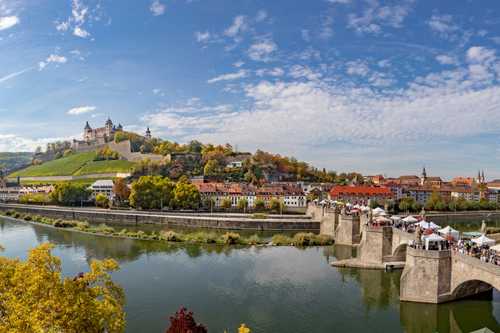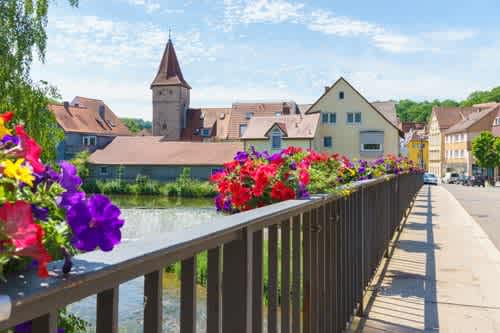A city of power in the Middle Ages, this historic city still boasts sever historic sites among its modern amenities.
About Ulm
ULM was an imperial city in the Middle Ages and a center of power. It is situated on the Danube River on the border with Bavaria in the German state of Baden-Württemberg. Ulm’s location on the Danube River and on the overland route from Munich to the Rhine gave it great economic control. Within the circle of walls, which were about 5 kilometers long (some are still standing to this day), is a vibrant city that combines the old and the new.
The Cathedral Ulm Munster (Ulmer Münster) is known throughout the world as the largest church which has the tallest spire in the world at about 161 meters. Because the “smell” of war was always “in the air” the original church was to be built on the edge of the city limits and therefore could be a refuge if people would need to escape from the city for safety. When the construction began at the end of the 1300’s, they built the church hall so it could accommodate up to 20,000 people. Unfortunately, the building was never finished until about 600 years later when finally with the residents financial assistance it became a reality and completed.
Ulm´s town hall (Ulmer Rathaus) is not far from the Cathedral. The facades of the Town Hall display the most lavish paintings and frescoes from the Renaissance period. After its proclamation as a town hall in the 15th century (in 1419 to be exact), the windows were fashioned with Gothic foundations onto which the statues of the electors were added. At the beginning of the 16th century, the golden astronomical clock, which also displays the months and the zodiac, was installed. The paintings visible today originate from the year 1900 when the previous paintings, which had been largely destroyed by the weather, were restored or renewed in the spirit of the surviving ones.
There is a statue, inside the town hall, of the inventor Albrecht Berblinger - the legendary Tailor of Ulm. It was he, who in 1808 built a mechanical flying system (purported to be a hang glider). Then, in front of the city walls in 1811, Berblinger gave a public demonstration, with some Royals in attendance as well, on how to “fly” - and failed miserably! He was thrust into the Danube River and fortunately saved by a few fishermen.
Definitely take the time to walk around this building to appreciate the art and decorative style all around. You will also see adjacent to Ulm Minster and the Town Hall, in the form of an imposing glass pyramid the Central Library Ulm.
Note: The façade of this library is made of close to 5000 m2 glass.
The Blau River, 22 km long, is a tributary of the Danube. The crystal-clear river splits into water channels and you just might find old flour mills on their banks. At its mouth is the Fisherman Quarter, a quaint village with half-timbered houses. The Quarter was home not only to fishermen but also to millers, sailors and tanners. You can walk through this town, stroll around narrow alleyways, shop in the galleries, relax in an enchanting restaurant or have a drink at the local pub. You just might feel that you are living life in a different century.
The Museum of Bread Culture (Museum Brot und Kunst) is unusual indeed, rather quaint, but an opportunity to get the inside story of baking and baking bread from centuries ago to these days. There is also a permanent exhibition of art based on the theme of Bread Baking including works by such masters as Rembrandt, Picasso etc.
And if you come at the right time of the year to Ulm, you can join in the festivities of The Great Carnival (Ulm Fastnacht). The highlight of these festivities is the parade which is held three weeks before the Fasnach Carnival. The ULMzug parade, expects about ten thousand spectators well as thousands of participants from Switzerland, Austria and Liechtenstein. Ever so colorful, boisterous and fun - real cool!
A Note from Ulm: Albert Einstein, the scientist and inventor of the theory of relativity, who received the Nobel Prize in physics in 1921, was born in Ulm on March 14,1879.
When he was just 15 months his family packed up and left Ulm never to return. This is a fact that is not relevant to the people of Ulm who claim him as “one of them”. There are a few Einstein statues and monuments throughout Ulm but the weirdest and notorious is the Einstein Fountain (Einstein Brunnen) created by Jurgen Goertz (in 1984) near the Cathedral on 15 Zeughausgasse (Street).
The sculpture was meant to be satiric as it is a hodge-podge of different items, a rocket, a snail shell with Einstein peering out – with a weird and mindless expression on his face.
Question: Known as a pacifist, why was ‘Einstein’ placed near the old arsenal?
Popular Itineraries
Traveled by thousands
Ulm Hotels
by

Attractions in Ulm
- Historic Center, Ulm
- Muenster, Ulm
- Ulmer Museum, Ulm











 Travel Perks
Travel Perks